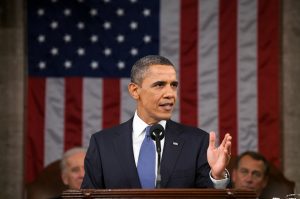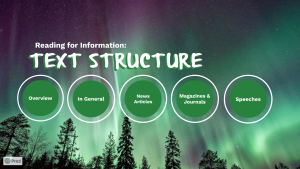32 Text Structure
Learning Objectives
-
Understand how the structure of a text can give information about its contents in Science and Social Studies texts.
-
Appropriately paraphrase and summarize texts.
Chapter & Discussion
This chapter includes a presentation that can be navigated in a classroom setting or independently. You can access the presentation via the link below.
Reading for Science and Social Studies: Text Structure
Work through the different sections of the chapter and discuss ideas and topics as they arise. If you’re working independently, take notes instead. Notes and active discussion will be helpful in navigating this week’s assignments.
Overview
On the GED (and in college and the workplace), you will need to quickly read a number of reading for information texts. This is anything that’s nonfiction.
We’re going to practice a number of skills to improve reading comprehension and fluency for these kinds of texts.
Today, we’re going to look at the structure of these texts to see if we can take advantage of elements like headings, transitions, visuals, and summaries to figure out how ideas are interrelated and make more sense of this kind of writing.
In General
Headings and Subheadings. They often provide an outline of the main points and help you understand the organization of the content.
First and Last. Read the introduction to grasp the main idea and purpose. The conclusion can summarize key points. This also works when reading the first and last sentence in a paragraph.
Paragraph Structure. Look at how paragraphs are organized. Topic sentences often indicate the main idea of the paragraph. Supporting details follow to strengthen the main point.
Lists and Bullet Points. Information presented in lists or bullet points is usually important. These formats make it easier to identify key points and details.
Bold or Italics Text. Words or phrases in bold or italics are often emphasized and may be key terms or concepts. Take note of them as they are likely important.
Transition Words. Words like “however,” “in addition,” or “therefore” indicate the relationship between ideas. Understanding these transitions helps in following the flow of the text.
Practice
Let’s compare this article with this scientific journal abstract. What differences did you notice? Which better helped you understand the facts of the story?
News Articles
News articles follow an inverted pyramid structure, placing the most essential information first and additional details later. This allows readers to gain the key takeaways even if they don’t finish the full article.
Headline – Catches the reader’s attention and conveys the main point
Byline – Lists the author and publication date/location
Lede– The lead is the opening paragraph of the article. It aims to provide a quick overview of the most essential information, answering the questions: who, what, when, where, why, and how.
The nut graph (nutshell paragraph) follows the lede and provides further context or background information. It helps readers understand the broader significance of the story.
Body – Elaborates on the details, quotes, facts, background, and various perspectives related to the news event. This is where the author provides evidence of their claims.
Conclusion – May restate the key details or provide a perspective on implications of the news.

Journal Articles
The structure of journal articles mirrors and reinforces the steps of the scientific method.
Abstract – Summarizes the key details and main findings of the article.
Introduction – Describes relevant background, specifies the research question, explains importance, and states hypotheses/objectives.
Methods – Tells us how they did the experiment.
Results – Tells us what happened in the experiment.
Discussion – Interprets meanings and significance of results to tell us what they learned.
Conclusion – Wraps up by revisiting the hypotheses and summarizing the implications supported by the evidence presented.
References – Cites all sources referred to allowing readers to verify credibility of supporting facts/claims.
Speeches
The structure of speeches is the opposite of a news article. Rather than starting with the main idea, speeches are designed to build up to it, using a foundation of background information and a logical pattern of ideas leading to a call to action.
Introduction – Gets the audience’s attention and clearly introduces the topic and purpose of the speech. Previews main ideas.
Background – Provides context, establishes speaker credibility/authority, offers insight on the issue, and orients the audience to key concepts.
Thesis statement – Outlines the central message, argument, or position on which the speech will elaborate.
Body – Uses supporting points, evidence, stories, examples and rhetorical techniques to flesh out the details of the thesis and appeal to audience values and logic. May have 2-4 main points that divide the body into sections.
Conclusion – Signals the end is near and ties back to the introduction. Sums up restating the thesis and main points as unified key takeaways.
Call to action – A rousing invitation for the audience to implement changes, make choices, embrace beliefs or take next steps aligned with the speaker’s argument.

Assigned Reading
Here are this week’s readings. Additionally, please read for your own personal enjoyment for 1/2 hour each day. This will be called your “Reading Zone” reading and it will coincide with many upcoming activities.
Academic Success Module: Reading (via Oregon State University)
Problem Set: Practice Your Skills!
Click here to complete a ten-question problem set on concepts in this chapter.
Completing problem sets like this can be an important element of independent study towards completing your HSE. I write these to resemble the style of questions you’ll find on the Reading and Language Arts GED.
Assignment: Text Structure (250 Words)
Set a timer for five minutes. Skim this chapter on the Neolithic Revolution. Using clues from the text’s structure, answer the following questions:
-
What is the main idea of this chapter?
-
Which Neolithic invention came first? What came next?
-
Where did this all happen?
Now, give yourself a timer for ten minutes and go back over your answers, filling in more details and expanding on your ideas.
Assignment: Reading Zone Response (250 Words)
For Reading Zone, you must find a novel that is interesting to you and enjoyable to read. If you need help finding a Reading Zone book, please ask. Please read your Reading Zone book for a half-hour each day. On class days, there will be time in class dedicated to reading.
Create a two-paragraph response to the reading you did this week. The first paragraph should summarize what you read this week. The second paragraph should address the following prompt:
Does this book explore topics that are related to your skills and interests? Or does it cover something that is completely new to you? What made you choose it? Is it meeting your needs and expectations as a reader?


